-
Posts
6,486 -
Joined
-
Last visited
-
Days Won
10
Content Type
Profiles
Forums
Blogs
Gallery
Events
Store
Posts posted by Brian Wolfe
-
-
Hello Phil,
An excellent post with very useful information. Your use of the English language is very good and quite easy to understand.
Than you for posting this valuable information.
Regards
Brian
Peter,
If only rejuvenation were possible through the application of grease I would fill a swimming pool with it and plunge in.

Regards from the "shelf-life expired",
Brian
0 -
One more try.
 0
0 -
Now for the view of the proof marks I mentioned.
I'm sorry that these are not clearer but this is exactly as the appear on the barrel.
It's been a while since I have added a firearm to the collection and I must say once this little beauty was in my hand it just felt right.
There are few things like that in life, swords being the other one.My wife cannot understand this but some weapons, whether firearm or sword just seems to become a part of your arm and you just know you belong together.

Thanks for any help you can give me.
Regards
Brian
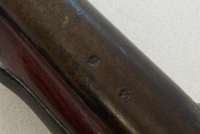 0
0 -
Here is a view of the the other side showing the belt hook.
Regards
Brian
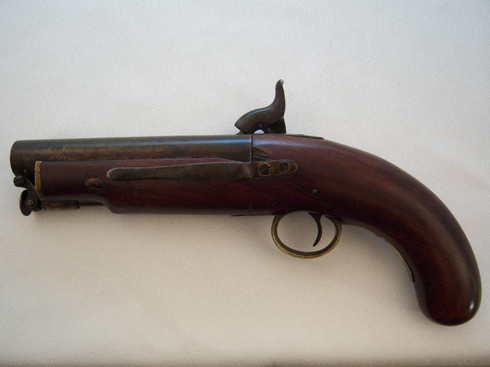 0
0 -
Hello Everyone,
I have just come into possession of this 20 mm smooth bore percussion cap muzzle loader and I hope some of the firearm enthusiasts within our membership can help with the identification. The full length is 12 inches with a 6 inch barrel and the stock is walnut. The bore is 20 mm across, the trigger guard is brass as is the ramrod fitting. There are two proof marks on the barrel that I cannot make out and the photographs are as clear as you can get and even to the naked eye are just as they appear in the photo.
The one mark is pretty well a “blob” but the other one looks like there is something crossed, lances or some such, that would be behind the crest or whatever the mark is. I hope that perhaps someone has seen something similar in their research and they can help me with the identification.
The country of origin and approximant date would be very helpful indeed. Any assistance you can extend to me would be greatly appreciated.
Regards
Brian
 0
0 -
This photos were too large to post together so here is the interior view.
Regards
Brian
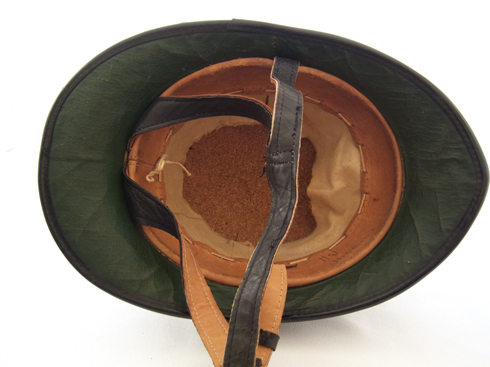 0
0 -
Before we get too far away from the topic of the Noddy I thought I'd post my Staffordshire example that I posted back in post #4 of this topic. The reason to post it again is to show the interior which I did not do earlier.
As can be seen the attachment straps are heavier than the "normal" helmet and behind the strip of light brown cloth is an extra layer of cork. Considering the officers of the day were not attempting to break the sound barrier like the cyclists you encounter on the highways today this double cork was probably fairly effective in countering blunt force trama to the head.
First the exterior.
Regards
Brian
 0
0 -
Hello Nick,
A nice addition to the thread. I kept saying to myself that I was not going to attempt to add one of these to my collection but every one I see makes me want to...well, we all now the rest of that thought.
Thanks for posting it.
Regards
Brian
0 -
Brian - these days I've lost track of the remaining parts of my collection. Should it be at the Bournemouth flat
then you can have it to go with your Staffs. version. Mervyn
Thank you very much Mervyn, you know I'll give it a good home.
Regards
Brian
0 -
The pattern of helmet with the double chin strap was for the Velocette air cooled m/cycle. Initially introduced
by the Met. in the early 1970's , it was intended to be used as a Beat patrol m/cycle. They did not last long, if
I remember correctly. Where they scored was in being able to offer assistance quickly and also, in delivering
messages.
The Met only used two patterns of helmet - the normal full sized one - with extra sheets of cork glued inside and
a later smaller, squatter version. This was from an idea submitted to Scotland Yard by a friend of mine - he was
awarded a cash sum for the idea. They are very rare. I think Brian had my version of this and perhaps he will post.
I have never seen a white version of this helmet - only the blue. However, a number of Forces adopted the Velocette
and - as we all know - Chief Constables are a law to themselves.
Hi Mervyn,
If I am the Brian you are talking about then I'm sorry to say that I don't have the squatter version of a Met. helmet. If you find it and wish to sell it please let me know.

I do have an example of the Noddy from the Staffordshire Police and it is shown in entry #4 of this post.
Regards
Brian
0 -
The Figure Of Eight Handcuffs Pouch in wear.
The wearing of police gear today.
Hello everyone,
I would like to discuss a couple of topics with this post. One is the leather pouch for the Figure Of Eight Handcuffs featured in a previous entry and the wearing of police gear on the duty belt today, especially handcuffs.
First the photo below is of an unidentified police officer wearing a leather handcuff pouch similar to the one in my previous post. The main difference is in the closure device. This one look like a dome and button while the RIC pouch has a tab that once inserted through the pouch flap is turned to lock the flap in place. The helmet in the photo shows a King’s crown and the only wording on the plate that can be made out is “County Constabulary”. I used magnification of different strengths and even my biology microscope and have found that the helmet was on such an angle as to leave the lettering of the municipality badly out of focus. However, we do know the officer in the photo is serving in the post Victorian era and that he wore the pouch in the front.
Today the police office can be seen, at least here in Canada, to be wearing the handcuffs case on the side or even at the back of the duty belt. With all of the gear that the modern police officer wears it is no wonder that, locally at least, it is referred to as the “Batman Utility Belt”. Officers in the past decade have taken to wearing a leather harness-style suspender system to take the weight of the belt off the officer’s hips. At first this seemed to be ridiculous and was just a fad that would never be accepted into the regulations. This has changed and now several police services have allowed the harness. Anyone who recalls the weight of the belt complete with side arm, asp (extendable baton), pepper spray, rubber glove pouch (or CPR pouch), handcuffs and the good old three cell Mag-Lite knows what hip joint pain feels like. Before I get too carried away with the gear in general I’ll get back to the handcuff pouch and where it is worn today.
When the officer is on foot patrol, or on a bicycle, wearing the pouch in the middle of the duty belt just below the small of the back works fairly well. It is out of the way of the rest of the gear and still easy to access, especially with the newer nylon pouch and Velcro closure. Now take that same officer and put him or her into the cruiser, or patrol car, and the location of the cuff pouch becomes a whole different matter. For those who have never experienced this less than pleasurable sensation take a carpenter’s tape measure, a twenty-five foot size is best for this experiment; clip it on your belt at the middle point of the waist at your back. It feels not too bad and I have worn one in that location on many a construction project in my distant past. Now jump in your car, truck or mini-van and drive to the corner store and back. Now you know how a handcuff pouch in that location feels to the police officer.
If you are stopped by an officer in a cruiser and you notice that the cuffs are at the side then you may have some room to plead your case for exceeding the speed limit. However if the case is worn in the small of the officer’s back simply apologize and tell him or her that you were wrong and were not paying attention to the speed limit posted. With luck maybe you get off with a warning, however, argue and...well...lets just say...DON”T ARGUE!
I’d like to hear for other officers, either current of former officers, on wearing your gear and your experiences.
Regards
Brian
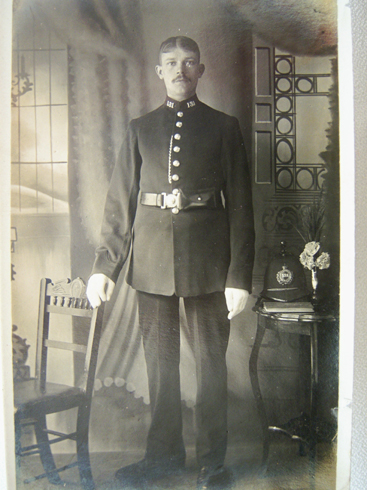
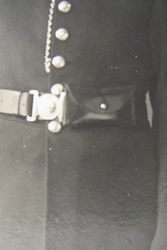 0
0 -
Welcome to the forum Geoff.
I can't help you with your question, however, don't get discouraged if an answer takes some time.
One of the other members or even a new member may see your question and be able to help.
If I find out anything I'll be sure to post it.
Regards
Brian
0 -
Sorry, it seems that the second photo was just too large to upload so here it is.
Regards
Brian
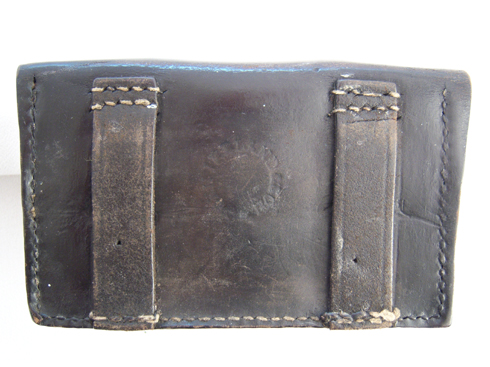 0
0 -
Here are a couple of views of the leather pouch.
REgards
Brian
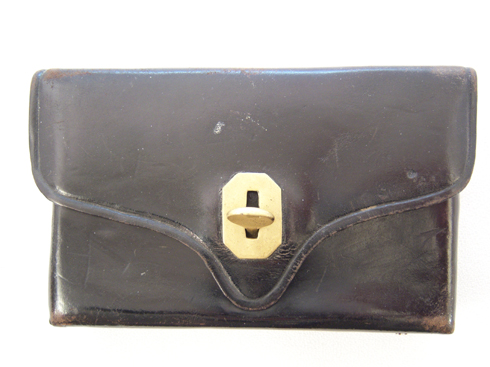 0
0 -
Hiatt, Figure Of Eight Handcuffs
Royal Irish Constabulary
This is a set of Hiatt, Figure Of Eight handcuffs from the Royal Irish Constabulary. The person I purchased this from told me he had purchased these “locally” meaning, where he lived, in Northern Ireland.
The cuffs came in their original leather case marked John Ireland & Son which is a manufacturer based in Dublin. I believe the key is a replacement and I think the photos support this belief.
The cuffs are marked “3” which is the size, and they are further marked “65” which I am guessing is the issue, or accountability, number.
Regards
Brian
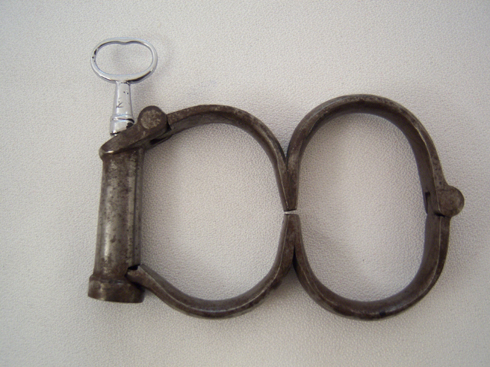 0
0 -
Nice pair of cuffs, Brian. The problem with the locking bar at the top is getting them to hold still
while you press it in. Mervyn
Thanks Mervyn and I agree about the locking device. It's probably a good idea to keep the detainee face down and horizontal until the cuffs are put on and "locked out". Then have them sit up crossed legged which makes getting them standing again a lot eaiser on your back. A knee to the small of the back applying pressure on the suspect while putting on the cuffs is, I understand, optional.

Regards
Brian
0 -
This is the leather pouch that was used with the handcuffs featured in this post.
I must admit that I have mixed feelings about leather verses the black nylon used today. Leather is a traditional material but unless taken care of properly it shows wear and lack of maintenance quickly. The nylon seems to stay looking "fresh" a lot longer and is cheaper to replace. I am sorry that I can't find the nylon pouch that I have to compaire the two and I suppose it is a moot point anyway since the leather kit is no longer in use.
Regards
Brian
 0
0 -
This is the original box for the cuffs.
Regards
Brian
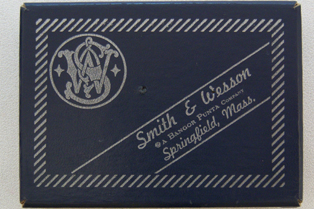
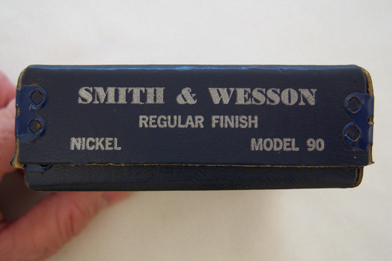 0
0 -
These next photos show the handcuffs with the key pointing to the locking device which prevents accidential tightening on the cuffs on the suspect's wrists. Since the cuffs came with only one key I decided to add an extra set and one of them is pictured along with the original. The maker's name is clearly stamped on the ring of the "new"key.
In case you are wondering why I would want a backup key, I've noticed that when anyone is looking at my collection and they are allowed to handle a pair of handcuffs the next thing you know they have fastened them either on themselves or on the wrists of their spouse. The last thing I need is to have to stop in at the local police station to have them remove a set of handcuffs because the key was lost. With my luck one of the Staffs I used to know would be on duty...I don't mind a good laugh but better at someone else's expense.

Regards
Brian
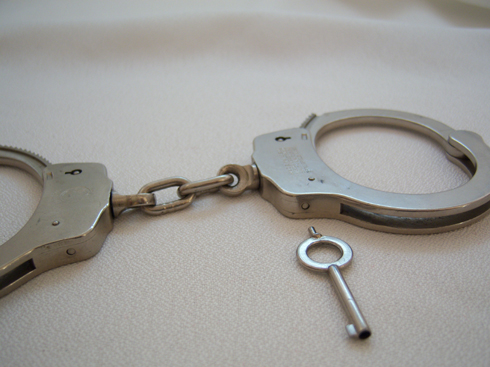
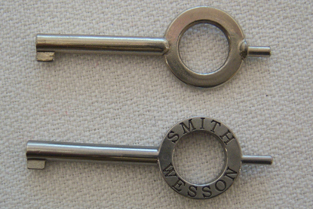 0
0 -
Smith and Wesson cuffs Model 90 – Canadian connection
I am showing a set of cuffs made in the USA by Smith and Wesson, even though they are not British or Canadian manufacture; however they were used here in Ontario, Canada, in or about 1965, though this style of S&W cuffs dates to c.1950 as far as manufacture is concerned. The group of items show with the cuffs were all from one officer who served in the Town or Elmira, Ontario. Elmira had its own police force until it was absorbed by the Waterloo Regional Police Service in 1973. I have read that at no time did the Elmira police force employ more than 15 officers so the hat badge show in the photo is fairly scarce.
A short story about the officer who gave me these items:
Tom (last name withheld) was a very young man when he joined the Elmira Police and on his first day of duty the Police Chief dropped dead on the main street of the town from a massive heart attack. Tom’s first duty was to take the Chief’s badge and gun from the hospital back to the station. He told me that he was really starting to doubt that joining the force had been a wise idea on his part.
One of the major differences between this style and the earlier Hiatt British ratchet style cuffs is the locking device that prevents the cuffs from tightening on the wrists of the suspect. The key has a protrusion that is used to push the locking device in, preventing accidental over tightening of the hand cuffs.
I was fortunate enough that Tom kept the original box for the set of handcuffs as well as his original leather handcuff pouch. Now most police services here in Ontario, Canada, use the black nylon pouches with the Velcro closure rather than the dome fastener seen on the leather pouch pictured below.
Regards
Brian
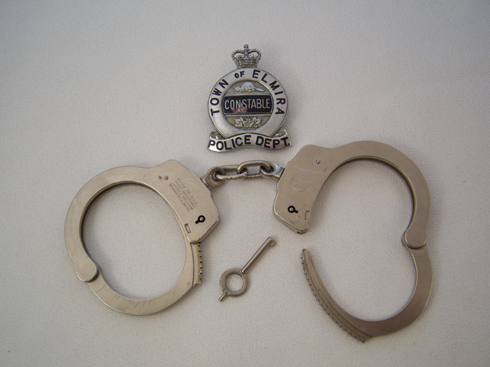 0
0 -
Hello,
There are several members who speak Japanese however the problem may be that they are not interested in swords and are just not reading your post.
Give it some more time and perhaps someone with that skill will answer.
I do collect Japanese items but don't speak or read their language, so I can understand your frustration.
Regards
Brian
0 -
Here is the photgraph mentioned above.
Sorry for the size and this may make the detail of the badge impossible to make out.
Regards
Brian

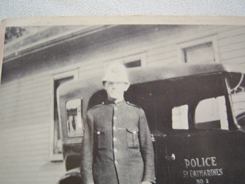 0
0 -
A Canadian Police helmet c. 1900
I have decided to place this helmet in the British section for a couple of reasons. First it was made in the UK and second I don’t expect we will see a flood of Canadian Police helmet posts so this will be a good place for it. If we do see a number of Canadian Police helmet posts I will move this one to the new section at that time.
A number of months ago a friend of mine alerted me to a Canadian police helmet for sale that was advertised as Victorian even though the badge was clearly a King’s crown. The price was right and I took the plunge and made the purchase. When it arrived I noticed that the helmet had three holes in the front for the attachment of a helmet plate. The badge that was on the helmet had the tabs bent out to accommodate the existing holes and once these matched the two lower holes the tabs were bent over on the inside. The helmet itself is an older cork model and was made in the UK, as was common in the early days. The maker is Christies of London.
Being a rather paranoid type, as most collectors are when it comes to the authenticity of specimens, I started to worry about the badge being correct to the helmet. The badge is a generic style with no indication of which police service used it. The seller said he purchased it in London Ontario Canada but was unsure of where it had actually been used. More research into the London Police is necessary to see if they indeed used this generic badge or not.
Earlier this week, while on a short vacation, I stopped in at an antiques “warehouse”, located in Barrie, Ontario, and found an interesting photo of a police officer standing in front of a police car. I am assuming this was a new police car and therefore the reason for the photo. Of course it could be a new police officer just as easily. Either way the car tells us that the officer was with the St.Catharines police which is near Niagara Falls Ontario. We can also see that they had at least two cars at the time. The vehicle itself is a 1925 Studebaker so we know about when this photo was taken. The feature I liked most about this photo was the white helmet with the same hat badge as on my helmet. It is worn higher than the one on my helmet but it is the same badge all the same.
The bad news about the photo is that when I got it home and used a magnifying glass to look at the badge I found out that the photo is not original. You can see the small dots that make up the image under magnification. This I find strange as even now when I look at the photo with the naked eye it appears to be an original photo. However the outline of the maple leaf and the white shape of the beaver are clear enough to verify, in my mind at least, that the badge on my helmet is original.
Here is what I believe happened to this helmet. Originally the helmet had a helmet plate during the late part of the Victorian era. When the Queen passed away there was a need to change the helmet plate to the new King’s crown pattern. Tax money for policing at the turn of the century here in Canada was not a priority with town and city councils so a smaller hat badge-style was decided upon for the police departments throughout the Province of Ontario if not the whole of the country. Since this particular helmet already had holes left from the removal of the plate the hat badge attachment tabs were simply modified and the badge applied to the helmet. This would also account for the lower location of the badge on the hat. This would place the helmet in the last years of the rein of Queen Victoria and the replacement badge in the first part of the rein of King Edward VII, which equates to the early 1900s.
As always I welcome comments on my speculations. As my research continues I will add the information to this article.
Regards
Brian
 0
0 -
Helo Cuffs,
Well, that blew me out of the water! What a great collection and from what you've told me it's only the tip of the iceberg.
I would really enjoy seeing more of your collection and thanks for posting these.
Regards
Brian
0




Japanese Sword - Wakizashi - Edo Period
in Swords & Edged Weapons
Posted
Hello Kelly,
I would indeed like to see more photos of your sword. I'm not sure what "circle with the cross" is unless it is the cherry blossom symbol found on the metal back piece on the handle which has two "taps" that extend onto the grip. As to having it professionally restored it can be a very costly process and not just anyone who says that can do this can actually do the work correctly. Not all blade damage is considered "fatal" but if the damage is really bad then it is not really worth the cost and money to send it to Japan for restoration. I've been told there are those in the US who can restore these blades but I don't know who they are, again, be very careful who you let do this.
I'll rrespond to your PM a bit later.
Regards
Brian